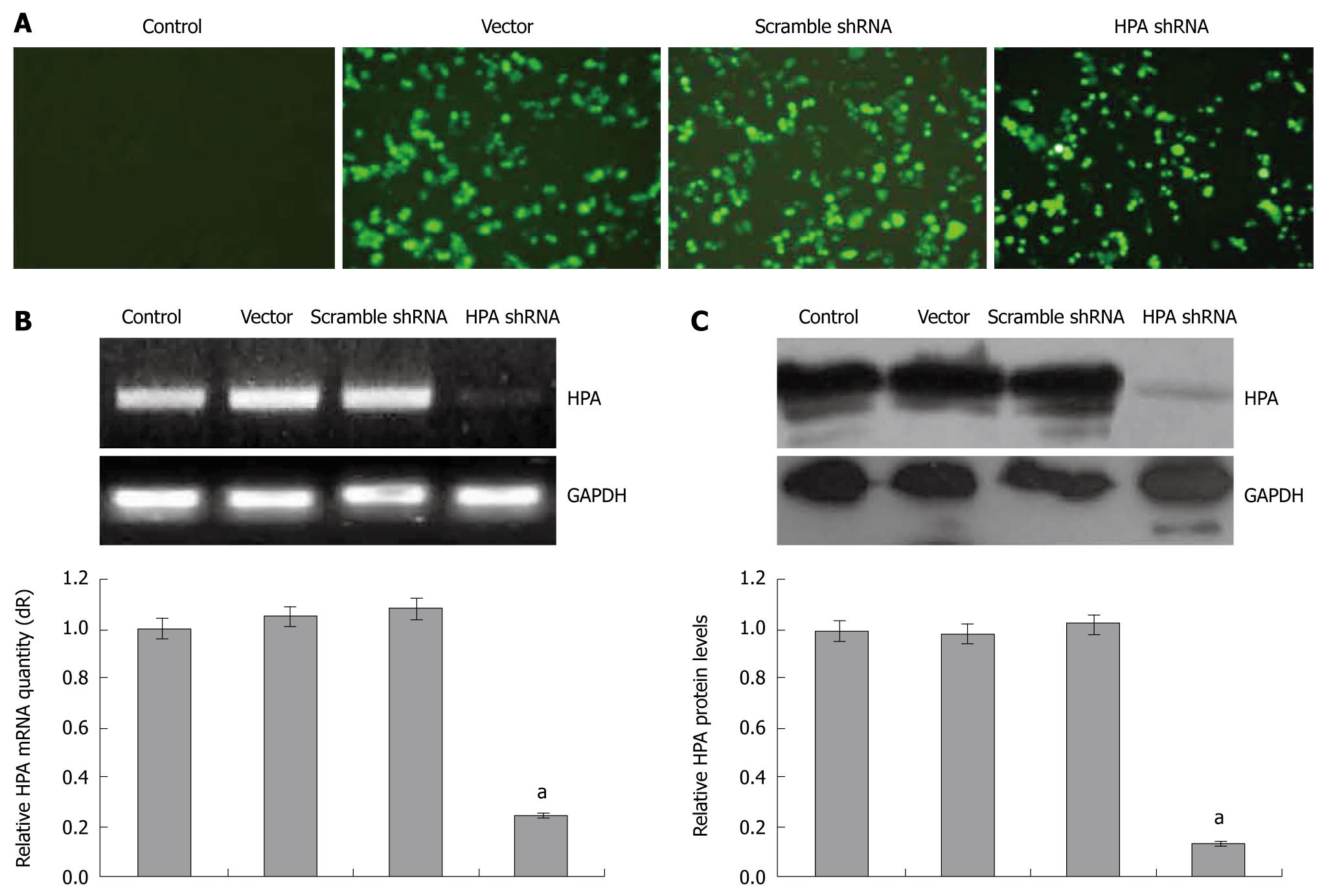Copyright
©2009 The WJG Press and Baishideng.
World J Gastroenterol. Nov 21, 2009; 15(43): 5442-5448
Published online Nov 21, 2009. doi: 10.3748/wjg.15.5442
Published online Nov 21, 2009. doi: 10.3748/wjg.15.5442
Figure 1 shRNA suppresses heparanase expression in gastric cancer cells.
A: The gastric cancer SGC-7901 cells were transfected with pGenesil-1, pGenesil-scrambled, and pGenesil-HPA. The transfection efficiency was monitored by the enhanced green fluorescent protein (EGFP) reporter within these vectors. The stable subclonal cells were screened by G418 selection; B: RT-PCR and real-time quantitative PCR indicated that stable transfection of empty vector (mock) and scrambled shRNA did not affect the mRNA level of heparanase. However, heparanase mRNA was significantly decreased in the stable shRNA-transfected cells; C: Western blot indicated that stable transfection of heparanase-specific shRNA, but not of scrambled shRNA or vector (mock), resulted in decreased heparanase protein expression in SGC-7901 cells. The symbol (a) indicates a significant (P < 0.05) decrease from parental cells. Experiments were performed in triplicate with essentially identical results.
Figure 2 Stable knockdown of heparanase does not affect the in vitro cell proliferation of gastric cancer cells.
A: MTT colorimetric assay indicated that stable transfection of shRNA did not affect the proliferation of SGC-7901 cells, when compared to the parental cells and mock group; B: In the colony formation assay, stable transfection of heparanase-specific shRNA, scrambled shRNA or vector (mock), did not influence the cell proliferation of cultured SGC-7901 cells. Experiments were performed in triplicate with essentially identical results.
Figure 3 Stable knockdown of heparanase abolishes the adhesion, migration and invasiveness of gastric cancer cells in vitro.
A: In the adhesion assay, SGC-7901 cells stably transfected with shRNA exhibited a markedly reduced ability into adhere to the precoated matrigel, when compared to parental cells and vector (mock) group. However, the cells stably transfected with scrambled shRNA had similar ability for adhesion as parental cells; B: In the wound healing assay, the cells stably transfected with heparanase-specific shRNA demonstrated an impaired migration capacity when compared to the parental cells and vector (mock) group; C: In transwell analysis, stable transfection of shRNA abolished the invasive capabilities of SGC-7901 cells, when compared to the parental cells and vector (mock) group. The symbol (a) indicates a significant (P < 0.05) decrease compared to parental cells. Experiments were performed in triplicate with essentially identical results.
Figure 4 Stable knockdown of heparanase inhibits in vitro angiogenesis of gastric cancer cells.
Extensive tube formation of endothelial cells was observed in parental and vector (mock) groups. However, when the endothelial cells were treated by the medium preconditioned with stable heparanase shRNA transfected SGC-7901 cells, tube formation was suppressed. The symbol (a) indicates a significant (P < 0.05) decrease compared to parental cells. Experiments were performed in triplicate with essentially identical results.
-
Citation: Zheng LD, Jiang GS, Pu JR, Mei H, Dong JH, Hou XH, Tong QS. Stable knockdown of heparanase expression in gastric cancer cells
in vitro . World J Gastroenterol 2009; 15(43): 5442-5448 - URL: https://www.wjgnet.com/1007-9327/full/v15/i43/5442.htm
- DOI: https://dx.doi.org/10.3748/wjg.15.5442












